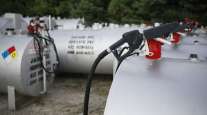Diesel Average Increases 1.9¢ to $3.971, Ending String of Five Straight Declines
This story appears in the April 28 print edition of Transport Topics.
The average retail price of diesel increased 1.9 cents to $3.971 a gallon last week, ending a five-week decline, the Department of Energy reported.
The increase last week means trucking’s main fuel now costs 8.4 cents more a gallon than it did in the corresponding week in 2013, even though the five-week decline had shaved 5 cents off the price of diesel, DOE said after its April 21 survey of fueling stations.
Diesel climbed to more than $4 a gallon in late February, a benchmark not reached since March 2013. During the price run-up this year, diesel hit $4.021 on March 10 before beginning its retreat.
Gasoline, meanwhile, last week continued what’s now an 11-week price climb, adding 3.2 cents to top off at $3.683 on average per retail gallon, DOE said after its April 21 survey of fueling stations.
Since Feb. 3, gasoline has in-creased 39 cents a gallon and costs nearly 15 cents more a gallon than it did a year ago.
Diesel and gasoline prices are up largely because of geopolitical factors such as the dispute in Ukraine, which have elevated crude oil prices, said Phil Flynn, an oil market analyst in Chicago for the Price Futures Group.
“That’s been keeping the diesel strong and, of course, we’ve been exporting a lot of diesel to other counties, and a lot of people are saying that’s driving up prices,” Flynn said.
One trucking executive said he is conducting an evaluation of his fleet’s entire operations.
“We were just looking at our fuel miles per gallon, and we’re not happy with it — [it’s] just lower than we want,” said Jeff Armstrong, president of Specialized Rail Service Inc., headquartered in Clearfield, Utah, just north of Salt Lake City.
“We’re only averaging, like, 4.68 miles per gallon,” Armstrong said. “We want to be up around at last 5 to 5.5.”
The evaluation will concentrate on drivers and equipment, he said, with the first step identifying poor performers in the 50-unit tractor fleet.
“We’re going to bring them in the shop, and we’re going to run an overhead on them and make sure there’s no problem with injectors or just do some general maintenance,” he said. “Then if we don’t get them to perform better, we’re going to move them out of the fleet and get newer trucks.”
He said the fleet buys only used trucks with about 300,000 miles and runs them for about four years or until they reach 800,000 to 1 million miles.
With newer, more fuel-efficient trucks, he estimated that he can save as much as $22,000 a year in fuel costs per truck. Armstrong also equipped his tractors with onboard recording equipment last year.
“Where we see drivers are maybe running at too-high rpm too often or their driver tendencies are not good, we’re going to discuss it with them,” he said, adding that he will reward good drivers in a bonus system.
Crude on the New York Mercantile Exchange has been more than $100 a barrel since April 3. On April 24, it closed at $101.94.
Flynn also said the demand for heating oil may have ebbed with winter temperatures, but diesel prices have held because farmers have begun buying diesel for the planting season.
Despite the high oil prices, Flynn and Timothy Hess, an analyst for DOE’s Energy Information Administration, both said record U.S. oil inventories are preventing crude prices from spiking further, which could send the diesel average price above $4.
As of April 18, there were 397.7 million barrels of crude on hand, more than at any other time since the United States began keeping weekly inventory data in 1982 and monthly data in 1920, DOE said.




